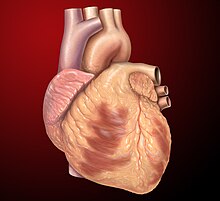Myocardial rupture
| Myocardial rupture | |
|---|---|
 | |
| Realistic view of the human heart | |
| Specialty | Cardiology |
Myocardial rupture is a laceration of the ventricles or atria of the heart, of the interatrial or interventricular septum, or of the papillary muscles. It is most commonly seen as a serious sequela of an acute myocardial infarction (heart attack).
It can also be caused by trauma.[1]
Signs and symptoms
Symptoms of myocardial rupture are recurrent or persistent chest pain, syncope, and distension of jugular vein. Sudden death caused by a myocardial rupture is sometimes preceded by no symptoms.[2]
Causes
The most common cause of myocardial rupture is a recent
]Risk factors for rupture after an acute myocardial infarction include female gender,[6][7] advanced age of the individual,[6][7] first ischemic event, and a low body mass index.[6] Other presenting signs associated with myocardial rupture include a pericardial friction rub, sluggish flow in the coronary artery after it is opened i.e. revascularized with an angioplasty, the left anterior descending artery being often the cause of the acute MI,[6][7][8] and delay of revascularization greater than 2 hours.[7]
Diagnosis
Due to the acute hemodynamic deterioration associated with myocardial rupture, the diagnosis is generally made based on physical examination, changes in the vital signs, and clinical suspicion. The diagnosis can be confirmed with echocardiography. The diagnosis is ultimately made at autopsy.[citation needed]
Classification
Myocardial ruptures can be classified as one of three types.[citation needed]
- Type I myocardial rupture is an abrupt slit-like tear that generally occurs within 24 hours of an acute myocardial infarction.
- Type II is an erosion of the infarcted myocardium, which is suggestive of a slow tear of the dead myocardium. Type II ruptures typically occur more than 24 hours after the infarction occurred.
- Type III ruptures are characterized by early aneurysm formation and subsequent rupture of the aneurysm.[9]
Another method for classifying myocardial ruptures is by the anatomical portion of the heart that has ruptured. By far the most dramatic is rupture of the free wall of the left or right ventricles, as this is associated with immediate hemodynamic collapse and death secondary to acute
The rupture will most often occur near the edge of the necrotic myocardium where it abuts healthy (but hyperemic) myocardium where the inflammatory response is at its greatest. Further, the rupture will occur in an area of greatest shear stress. Within the left ventricle, these areas are adjacent to both anterior and posterior papillary muscles (regardless of whether the papillary muscle is involved in the infarction).[citation needed]
Left ventricular free wall rupture almost always results in hemopericardium (the exception being in the scenario where the patient has had prior open heart surgery and has obliterative fibrous pericardial adhesions; these would prevent egress of blood) and pericardial tamponade. An accumulation of as little as 75 ml of blood, acquired acutely in a patient without pre-existing pericardial effusion, is sufficient to produce tamponade (wherein the ventricles are incapable of filling and are thus incapable of producing adequate stroke volume).[citation needed]
Treatment
The treatment for myocardial rupture is supportive in the immediate setting and surgical correction of the rupture, if feasible.[citation needed] A certain small percentage of individuals do not seek medical attention in the acute setting and survive to see the physician days or weeks later. In this setting, it may be reasonable to treat the rupture medically and delay or avoid surgery completely, depending on the individual's comorbid medical issues.[citation needed]
Prognosis
The prognosis of myocardial rupture is dependent on a number of factors, including which portion of the myocardium is involved in the rupture. In one case series, if myocardial rupture involved the free wall of the
Incidence
The incidence of myocardial rupture has decreased in the era of urgent revascularization and aggressive
References
- PMID 19540491.
- ^ http://emedicine.medscape.com/article/156455-clinical%7C date retrieved January 2017
- ^ Figueras J, Alcalde O, Barrabes JA, Serra V, Alguersuari J, Cortadellas J, et al. Changes in Hospital Mortality Rates in 425 Patients with Acute ST-Elevation Myocardial Infarction and Cardiac Rupure Over a 30-Year Period. Circulation. 2008;118:2783–9.
- ^ PMID 16461195.
- PMID 16569654.
- ^ PMID 12907544. Archived from the original(PDF) on 2007-06-15. Retrieved 2007-04-25.
- ^ PMID 11849857.
- PMID 12888132.
- PMID 1193118.
- PMID 8626938.
